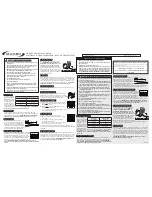
17
21-18CS
Instruction & User Manual
m
When cutting across the grain, the fibers of
the wood have a tendency to lift and tear,
moving the saw slowly minimizes this effect.
m
Only use saw blades recommended by
the manufacturer, which conform to EN
847-1, if intended for wood and analogous
materials.
m
Only use only blade diameter(s) in
accordance with the markings.
Pocket Cutting
m
Disconnect the tool from the power supply
before making any adjustments. Set the
depth adjustment based on the thickness of
the line drawing for the cut. Raise the lower
guard by using the lift lever.
m
With the blade barely above the material
to be cut, start the saw and allow the blade
to come to full speed. Gradually lower the
blade into the material to be cut using the
front end of the shoe as a pivot point.
m
When the blade starts cutting, release the
lower guard.
m
When the shoe is resting flat on the surface
being cut, proceed cutting in a forward
direction to the end of the cut.
m
Allow the blade to come to a full stop
before removing it from the cut.
Never pull the saw backward since the blade
will climb out of the cut and kickback will
occur.
WARNING!
m
Turn the saw around and finish the cut in
a normal manner, sawing forward. Use a
jigsaw or a hand saw to finish the cut in the
corners, if required.
Cutting Large Sheets
m
Large sheet or boards require support to
prevent bends or sags. If you attempt to cut
without leveling and properly supporting
the work piece, the blade will tend to bind,
causing kickback.
m
Support the panel or board close to the
cut. Be sure to set the blade adjustment
so that you can cut through the material
without cutting into the table or workbench.
Suggestion: use two by fours to support the
board or panel to be cut. If the piece is too
large for the workbench, use the floor with
the two-by fours supporting the wood.
2825 21-18CS Circular Saw Manual.indd 17
2825 21-18CS Circular Saw Manual.indd 17
08/07/2021 14:51
08/07/2021 14:51






































